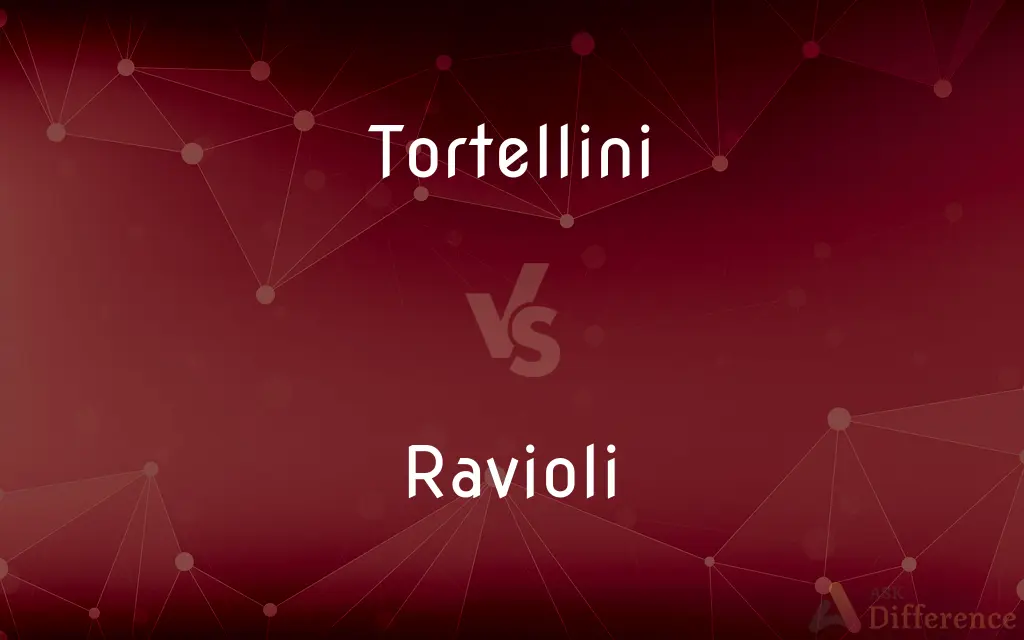Tortellini vs. Ravioli — What's the Difference?
By Fiza Rafique & Urooj Arif — Updated on March 30, 2024
Tortellini are small, ring-shaped pastas usually stuffed with cheese or meat, while ravioli are larger, square or rectangle pillows filled with a variety of ingredients.

Difference Between Tortellini and Ravioli
Table of Contents
ADVERTISEMENT
Key Differences
Tortellini and ravioli are both traditional Italian pasta, beloved around the world for their delicious fillings and versatile sauce pairings. Tortellini, often smaller and ring-shaped, is traditionally filled with a mix of meat (pork loin, raw prosciutto, and mortadella), Parmigiano Reggiano cheese, egg, and nutmeg. Ravioli, on the other hand, presents itself in larger square or rectangular shapes and can be filled with cheese, vegetables, meats, or even seafood, offering a broader range of flavors.
The origin of tortellini is associated with the Emilia-Romagna region of Italy, particularly the area around Bologna and Modena, where they are a staple of the local cuisine. Ravioli, while also popular in northern Italy, have a more widespread origin, with variations found across the country, reflecting the local ingredients and culinary traditions of each region.
In terms of preparation, tortellini are often served in broth (brodo), making them a popular choice for Italian festive feasts, especially during Christmas or New Year’s Eve. Ravioli are more commonly served with a sauce, such as a simple tomato sauce, sage and butter, or even more complex, creamy sauces, highlighting their versatility in terms of serving options.
Another distinction lies in their cultural significance. Tortellini have a rich folklore, with legends attributing their shape to the navel of Venus, the goddess of love, emphasizing their role in Italian culinary tradition. Ravioli, while less encumbered by myth, have been a part of Italian cuisine since the Middle Ages, showcasing the historical depth of Italian gastronomy.
Despite their differences, both pasta types are celebrated for their ability to convey the richness of Italian culinary heritage, bringing together family and friends over dishes that are as much about the joy of eating as they are about the art of cooking.
ADVERTISEMENT
Comparison Chart
Shape
Small, ring-shaped
Larger, square or rectangular
Traditional Fillings
Meat, cheese, egg, nutmeg
Varied: cheese, meats, vegetables, seafood
Serving
Often in broth
Typically with a sauce
Origin
Emilia-Romagna region, Italy
Widespread across Italy
Cultural Significance
Associated with folklore and tradition
Historical presence since the Middle Ages
Compare with Definitions
Tortellini
A small, ring-shaped pasta filled with a mixture of meats and cheese.
Tortellini in brodo is a traditional Italian dish served during the holidays.
Ravioli
Has a historical presence since the Middle Ages.
Ravioli were originally a way to stretch ingredients and feed more people.
Tortellini
Symbolic in Italian folklore.
Tortellini are said to mimic the navel of Venus, adding a touch of romance to their culinary appeal.
Ravioli
Commonly served with a sauce rather than in broth.
Mushroom ravioli with sage butter is a simple yet flavorful dish.
Tortellini
Originating from the Emilia-Romagna region of Italy.
When visiting Bologna, trying the local tortellini is a must.
Ravioli
A type of pasta that comes in square or rectangular pillows filled with various ingredients.
Spinach and ricotta ravioli are a classic vegetarian option.
Tortellini
Traditionally served in a clear broth.
A warm bowl of tortellini in brodo is comforting on a cold day.
Ravioli
Reflects regional Italian culinary traditions.
Pumpkin ravioli are a specialty of Northern Italy, perfect for autumn.
Tortellini
Celebrated for their delicate shape and rich fillings.
Homemade tortellini are a testament to the art of Italian pasta making.
Ravioli
Known for its versatility in fillings and sauces.
Lobster ravioli served with a creamy saffron sauce is a luxurious dish.
Tortellini
Tortellini are ring-shaped pasta originally from the Italian region of Emilia (in particular Bologna and Modena). Traditionally they are stuffed with a mix of meat (pork loin, raw prosciutto, mortadella), Parmigiano Reggiano cheese, egg and nutmeg and served in capon broth (in brodo di cappone).In the area of origin they are usually sold fresh or home-made.
Ravioli
Ravioli (Italian pronunciation: [raviˈɔli]; singular: raviolo, pronounced [raviˈɔlo]) are a type of pasta comprising a filling enveloped in thin pasta dough. Usually served in broth or with a sauce, they originated as a traditional food in Italian cuisine.
Tortellini
Pasta in small rings stuffed usually with meat or cheese and served in soup or with a sauce.
Ravioli
Small pasta envelopes containing minced meat, fish, cheese, or vegetables, usually served with a sauce.
Tortellini
Small, ring-shaped pasta, stuffed with meat, cheese etc; eaten with a sauce or in a soup
Ravioli
A small casing of pasta with any of various fillings, such as chopped meat or cheese.
Tortellini
Small ring-shaped stuffed pasta
Ravioli
A dish made with ravioli.
Ravioli
Plural of raviolo
Ravioli
Small square parcels of pasta filled with meat, cheese, spinach etc.
Ravioli
A dish made with ravioli.
Ravioli
(informal) by analogy, similar dishes/pastas from non-Italian cuisines.
Ravioli
Small circular or square cases of dough with savory fillings
Common Curiosities
How are tortellini and ravioli served?
Tortellini are often served in broth, whereas ravioli are usually served with a sauce.
Is making tortellini or ravioli harder?
The difficulty can vary based on the complexity of the fillings and shapes, with tortellini often considered more challenging due to its smaller size and shape.
Where does tortellini originate from?
Tortellini originates from the Emilia-Romagna region of Italy.
Can ravioli and tortellini fillings be the same?
While there can be overlap, such as cheese fillings, each pasta traditionally has distinct fillings reflecting their origins.
What is tortellini?
Tortellini is a small, ring-shaped pasta traditionally filled with a mix of meat and cheese.
Do tortellini and ravioli taste the same?
The taste can vary significantly due to differences in fillings and how they are served.
Can tortellini be served with sauce?
Yes, though traditionally served in broth, tortellini can also be enjoyed with sauce.
What is the cultural significance of tortellini?
Tortellini are linked to Italian folklore, symbolizing the navel of Venus.
Why are ravioli considered versatile?
Ravioli's versatility comes from the wide range of possible fillings and sauce pairings.
What is ravioli?
Ravioli is a pasta that comes in square or rectangular shapes, filled with a variety of ingredients like cheese, vegetables, or meat.
What makes tortellini unique?
Its small, ring-shaped design and traditional filling of meat and cheese make it distinctive.
Are tortellini and ravioli served at the same occasions?
Both can be served at various occasions, but tortellini in broth is particularly popular during Italian festive feasts.
What sauces go well with ravioli?
Tomato sauce, sage and butter, or creamy sauces are popular choices for ravioli.
Can vegetarian options be found for both pastas?
Yes, both tortellini and ravioli offer vegetarian filling options.
How long have ravioli been part of Italian cuisine?
Ravioli have been a staple since the Middle Ages, reflecting the depth of Italian culinary tradition.
Share Your Discovery

Previous Comparison
Medulla vs. Cortex
Next Comparison
Keurig vs. NespressoAuthor Spotlight
Written by
Fiza RafiqueFiza Rafique is a skilled content writer at AskDifference.com, where she meticulously refines and enhances written pieces. Drawing from her vast editorial expertise, Fiza ensures clarity, accuracy, and precision in every article. Passionate about language, she continually seeks to elevate the quality of content for readers worldwide.
Co-written by
Urooj ArifUrooj is a skilled content writer at Ask Difference, known for her exceptional ability to simplify complex topics into engaging and informative content. With a passion for research and a flair for clear, concise writing, she consistently delivers articles that resonate with our diverse audience.
















































